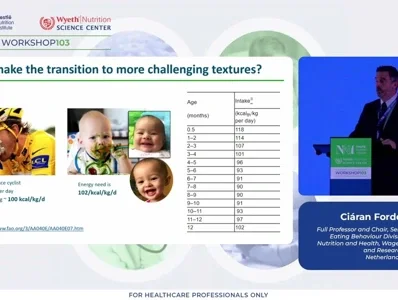Learning to Eat: Exploring Food Texture and Eating Behavior
Learning to Eat: The Role of Early-Life Texture Experiences in the Development of Eating Behaviors
Ciarán G. Forde
Professor and Chair; Sensory Science and Eating Behaviour, Division of Human Nutrition and Health, Wageningen University and Research, the Netherlands
Eating behaviors develop in early life and are further refined during childhood, shaping life-long food habits and dietary patterns. New-born infants rely on innate reflexes such as sucking, swallowing, and rooting to meet their daily energy and nutrient requirements 1. During infancy and early childhood, children have high nutrient and energy requirements relative to their size, due to the energy cost of growth and development. Importantly, the eating skills and texture experiences acquired and refined in early life also have a direct influence on the development of oral anatomy and physiology 2. These early life feeding skills emerge from the physiological and neuronal developments acquired over time and through experiences with food textures that help to stimulate oral anatomy development and the emergence of stable eating behaviors. Infants transition at around 6-months from supine, dependent feeding with liquid foods such as breast or bottle feeding, to upright, independent feeding with semi-solid and solid foods. This rapid period of learning coincides with considerable anatomical and physiological changes, as the infant must learn to balance their head while their first teeth emerge, and they develop the muscle coordination needed to chew and orally process textured foods. Chewing is a learned complex motor-task and is the result of the coordination of 26 muscle pairs and 5 cranial nerves, to grip/bite, masticate and safely swallow the food being consumed. Each food texture experience is an opportunity for the infant to refine the skills needed to safely manipulate and swallow food, and each new texture challenge has to be ‘learned’ as different foods require unique combinations of oral processing skills to manipulate and swallow a bolus safely.
Despite the importance of early life texture experiences, research has shown a relatively poor alignment between the age-appropriate recommendations made on food products and the consistency of textured weaning products 3. Parents often rely on age or cues from their toddler to assess their ‘readiness’ to transition to more complex textures, yet research has shown that neither age nor number of teeth can adequately explain differences in an infant’s ability to orally manipulate and breakdown food. A child’s developmental stage and experience across a diverse range of different food textures is likely to be a better predictor of oral processing skill development. Toddlers that have developed more advanced chewing skills tend to exhibit higher acceptance for a broader range of food textures than those with a more narrow texture exposure and less developed oral processing skills. These chewing skills shape the eating behaviors that become stable and carry forward into later childhood, such as a habitual fast or slow eating rate and associated differences in energy intake and weight status. Research has shown that differences in habitual eating speed among school-age children are associated with energy intakes, weight status (BMI-z score) and adiposity levels 4 and serve to moderate the risk of over-weight in later childhood 5. Understanding how early life texture experiences drive the development of these oral processing skills is central to supporting the normal development of oral anatomy and the adoption of healthier eating patterns that support optimal growth and development.
References:
1. Tournier, C., & Forde, C. G. (2024). Food oral processing and eating behavior from infancy to childhood: evidence on the role of food texture in the development of healthy eating behavior. Critical Reviews in Food Science and Nutrition , 64 (26), 9554-9567
2. Le Révérend, B. J., Edelson, L. R., & Loret, C. (2014). Anatomical, functional, physiological and behavioural aspects of the development of mastication in early childhood. British Journal of Nutrition, 111(3), 403-414.
3. Tan, V. W. K., Lim, A. J., McCrickerd, K., & Forde, C. G. (2022). Sensory profiles and mothers’ expectations and beliefs about age appropriate snacks for infants and toddlers in Singapore. Food Quality and Preference, 97, 104474.
4. Fogel, A., Goh, A.T., Fries, L.R., Sadananthan, S.A., Velan, S.S., Michael, N., ... & Forde, C.G. (2017). Faster eating rates are associated with higher energy intakes during an ad libitum meal, higher BMI and greater adiposity among 4.5-year-old children: Results from the Growing Up in Singapore Towards Healthy Outcomes (GUSTO) cohort. British Journal of Nutrition, 117 (7), 1042-1051.
5. Fogel, A., McCrickerd, K., Aris, I.M., Goh, A.T., Chong, YS, Tan, K.H., ... & Forde, C.G. (2020). Eating behaviours moderate the associations between risk factors in the first 1000 days and adiposity outcomes at 6 years of age. The American Journal of Clinical Nutrition, 111 (5), 997-1006.
If you liked this post you may also like

